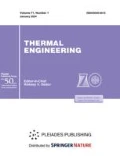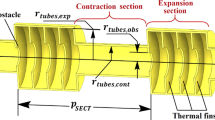Abstract
Entropy production during hydrogen-air diffusion in the combustion chamber (СС) was studied. A two-dimensional axisymmetric combustion chamber is considered in this paper. The numerical simulation of combustion has been done by Fluent software. The entropy production per unit volume for heat conduction and convection, mass diffusion, viscous dissipation, and the chemical reaction was calculated by user-defined function (UDF) post-processing, while the entropy production for heat transfer radiation was determined by post-processing with the help of calculated data of temperature. The results reveal that the radiation entropy production cannot be omitted when second law analysis of thermodynamic is adopted in high-temperature conditions such as boilers, heat exchangers, furnaces, etc; in these devices, thermal radiation is the basic mode of heat transfer. The effects of parameters such as Boltzmann number and Reynolds number on entropy production and entropy production number are analyzed. It is shown that the total entropy production number first decreases with the increase Reynolds and Boltzmann numbers; and then gradually increases. The results provide a theoretical reference for the improvement of thermodynamic efficiency for heat transfer and energy utilization.





Similar content being viewed by others
REFERENCES
A. Bejan and J. Kestin, “Entropy generation through heat and fluid flow,” J. Appl. Mech. 50, 475 (2009). https://doi.org/10.1115/1.3167072
A. Bejan, “The method of entropy generation minimization,” Energy Environ. 15, 11–22 (2011). https://doi.org/10.1007/978-94-011-4593-0_2
A. Bejan, “Second-law analysis in heat transfer and thermal design,” Adv. Heat Transfer 15, 1–58 (1982). https://doi.org/10.1016/S0065-2717(08)70172-2
A. Bejan, Advanced Engineering Thermodynamics (Wiley, New York, 2016). https://doi.org/10.1002/9781119245964.
T. H. Ko and K. Ting, “Entropy generation and optimal analysis for laminar forced convection in curved rectangular ducts: A numerical study,” Int. J. Therm. Sci. 45, 138–150 (2006). https://doi.org/10.1016/j.ijthermalsci.2005.01.010
K. Hooman, H. Gurgenci, and A. A. Merrikh, “Heat transfer and entropy generation optimization of forced convection in porous-saturated ducts of rectangular cross-section,” Int. J. Heat Mass Transfer 50, 2051–2059 (2007). https://doi.org/10.1016/j.ijheatmasstransfer.2006.11.015
N. E. Gharbi, A. Kheiri, M. E. Ganaoui, and R. Blanchard, “Numerical optimization of heat exchangers with circular and non-circular shapes,” Case Stud. Therm. Eng. 6, 194–203 (2015). https://doi.org/10.1016/j.csite.2015.09.006
C. Balaji, M. Hölling, and H. Herwig, “Entropy generation minimization in turbulent mixed convection flows,” Int. Commun. Heat Mass Transfer 34, 544–552 (2007). https://doi.org/10.1016/j.icheatmasstransfer.2007.01.015
M. Zeinalpour and K. Mazaheri, “Entropy minimization in turbine cascade using continuous adjoint formulation,” Eng. Optim. 48, 213–230 (2016). https://doi.org/10.1080/0305215X.2014.998663
F. Kock and H. Herwig, “Local entropy production in turbulent shear flows: A high-Reynolds number model with wall functions,” Int. J. Heat Mass Transfer 47, 2205–2215 (2004). https://doi.org/10.1016/j.ijheatmasstransfer.2003.11.025
F. Kock and H. Herwig, “Entropy production calculation for turbulent shear flows and their implementation in cfd codes,” Int. J. Heat Fluid Flow 26, 672–680 (2005). https://doi.org/10.1016/j.ijheatfluidflow.2005.03.005
B. A. K. Abu-Hijleh, M. Abu-Qudais, and E. Abu Nada, “Numerical prediction of entropy generation due to natural convection from a horizontal cylinder,” Energy 24, 327–333 (1999). https://doi.org/10.1016/S0360-5442(98)00103-0
M. Kooshkbaghi, C. E. Frouzakis, K. Boulouchos, and I. V. Karlin, “Entropy production analysis for mechanism reduction,” Combust. Flame 161, 1507–1515 (2014). https://doi.org/10.1016/j.combustflame.2013.12.016
T. W. F. Russell, A. S. Robinson, and N. J. Wagner, Mass and Heat Transfer: Analysis of Mass Contactors and Heat Exchangers (Cambridge Univ. Press, Cambridge, 2013).
X. Zhang, W. Zhang, and X. Zhang, “Entropy analyses of droplet combustion in convective environment with small Reynolds number,” Chin. J. Chem. Eng. 21, 654–662 (2013). https://doi.org/10.1016/S1004-9541(13)60526-1
A. Datta, “Effects of gravity on structure and entropy generation of confined laminar diffusion flames,” Int. J. Eng. Sci. 44, 429–440 (2005). https://doi.org/10.1016/j.ijthermalsci.2004.10.003
S. Mahmud and R. A. Fraser, “Mixed convection-radiation interaction in a vertical porous channel: Entropy generation,” Energy 28, 1557–1577 (2003). https://doi.org/10.1016/S0360-5442(03)00154-3
R. A. Bortolozzi and J. A. Deiber, “Effects of thermal spot configurations on the flow through porous media driven by natural and forced convection,” Int. J. Heat Mass Transfer 48, 3294–3307 (2005). https://doi.org/10.1016/j.ijheatmasstransfer.2005.02.025
M. Shohel and F. R. Andrew, “Analysis of mixed convection — Radiation interaction in a vertical channel: Entropy generation,” Exergy, Int. J. 2, 330–339 (2002). https://doi.org/10.1016/S1164-0235(02)00075-4
G. Hazarika and J. Konch, “Effects of variable viscosity and thermal conductivity on magnetohydrodynamic free convective flow along a vertical porous plate with viscous dissipation,” Turk. J. Phys. 40, 52–68 (2015). https://doi.org/10.3906/fiz-1509-14
M. Caldas and V. Semião, “The effect of turbulence-radiation interaction on radiative entropy generation and heat transfer,” J. Quant. Spectrosc. Radiat. Transfer 104, 12–23 (2007). https://doi.org/10.1016/j.jqsrt.2006.08.006
P. J. Coelho, “Numerical simulation of the interaction between turbulence and radiation in reactive flows,” Prog. Energy Combust. Sci. 33, 311–383 (2007). https://doi.org/10.1016/j.pecs.2006.11.002
C. Tregambi, R. Chirone, F. Montagnaro, P. Salatino, and R. Solimene, “Heat transfer in directly irradiated fluidized beds,” Sol. Energy 129, 85–100 (2016). https://doi.org/10.1016/j.solener.2016.01.057
T. Kogawa, J. Okajima, A. Sakurai, A. Komiya, and S. Maruyama, “Influence of radiation effect on turbulent natural convection in cubic cavity at normal temperature atmospheric gas,” Int. J. Heat Mass Transfer 104, 456–466 (2017). https://doi.org/10.1016/j.ijheatmasstransfer.2016.08.059
L. H. Liu and S. X. Chu, “Verification of numerical simulation method for entropy generation of radiation heat transfer in semitransparent medium,” J. Quant. Spectrosc. Radiat. Transfer 103, 43–56 (2007). https://doi.org/10.1016/j.jqsrt.2006.07.004
M. Caldas and V. Semiao, “Entropy generation through radiative transfer in participating media: Analysis and numerical computation,” J. Quant. Spectrosc. Radiat. Transfer 96, 423–437 (2005). https://doi.org/10.1016/j.jqsrt.2004.11.008
“The theory of heat,” Nature 105, 228 (1920). https://doi.org/10.1038/105228a0
M. Goodarzi, M. R. Safaei, H. F. Oztop, A. Karimipour, E. Sadeghinezhad, M. Dahari, S. N. Kazi, and N. Jomhari, “Numerical study of entropy generation due to coupled laminar and turbulent mixed convection and thermal radiation in an enclosure filled with a semitransparent medium,” Sci. World J. 2014, 761745 (2014). https://doi.org/10.1155/2014/761745
J. Meseguer, I. Pérez-Grande, and A. Sanz-Andrés, “Thermal radiation heat transfer,” in Spacecraft Thermal Control (Woodhead, Oxford, 2012), pp. 73–86. https://doi.org/10.1533/9780857096081.73
E. Liu, H. Wang, J. Mi, C. Niu, and X. Xu, “Numerical simulation of effect of magnetizer on magnetic field of induction melting furnace,” 3D Res. 10, 213 (2019). https://doi.org/10.1007/s13319-018-0213-8
A. Pourfarzaneh, A. Jafarian, and H. Kharinezhad Arani, “Numerical study of particulate turbulent flow to investigate recovery period in cleanrooms,” Sci. Iran. 26, 331–345 (2019). https://doi.org/10.24200/sci.2018.20322
C. G. Carrington and Z. F. Sun, “Second law analysis of combined heat and mass transfer phenomena,” Int. J. Heat Mass Transfer 34, 2767–2773 (1991). https://doi.org/10.1016/0017-9310(91)90235-7
K. Nishida, T. Takagi, and S. Kinoshita, “Analysis of entropy generation and exergy loss during combustion,” Proc. Combust. Inst. 29, 869–874 (2002). https://doi.org/10.1016/S1540-7489(02)80111-0
S. M. Ali, V. Raghavan, and S. Tiwari, “A study of steady laminar diffusion flame over methanol pool surface,” Int. J. Heat Mass Transfer 53, 4696–4706 (2010). https://doi.org/10.1016/j.ijheatmasstransfer.2010.06.022
K. Safer, A. Ouadha, and F. Tabet, “Entropy generation in turbulent syngas counterflow diffusion flames,” Int. J. Hydrogen Energy 42, 29532–29544 (2017). https://doi.org/10.1016/j.ijhydene.2017.08.217
W. Ahmed, M. M. Sufyan Beg, and T. Ahmad, “Entropy based feature selection for fuzzy set-valued information systems,” 3D Res. 9, 170 (2018). https://doi.org/10.1007/s13319-018-0170-2
C. Zou and Y. Yin, “Multi-phase fluid simulation based on narrow-band FLIP method,” 3D Res. 9, 173 (2018). https://doi.org/10.1007/s13319-018-0173-z
E. Mahdavi, M. Haghighi-Yazdi, M. Baniassadi, M. Tehrani, S. Ahzi, and J. Jamali, “Analytical solution of governing equations of triple coupled physics of structural mechanics, diffusion, and heat transfer,” Sci. Iran., Trans. B 25, 2738–2757 (2018). https://doi.org/10.24200/sci.2018.20449
Author information
Authors and Affiliations
Corresponding author
Additional information
This work is supported by the Foundation for Innovative Research Groups of the National Natural Science Foundation of China (Grant nos. 51776050 and 51536001), The Higher Education Commission (HEC) of Pakistan and Mehran University of Engineering and Technology, Jamshoro, Sindh, Pakistan.
Rights and permissions
About this article
Cite this article
Ali Anwar Brohi, Zhang, HC. & Karim, S. Numerical Analysis of Entropy Production during Hydrogen-Air Burner Combustion Process. Therm. Eng. 67, 304–313 (2020). https://doi.org/10.1134/S0040601520050031
Received:
Revised:
Accepted:
Published:
Issue Date:
DOI: https://doi.org/10.1134/S0040601520050031




